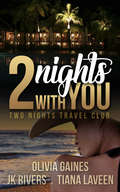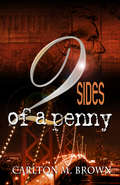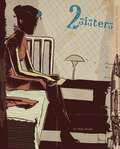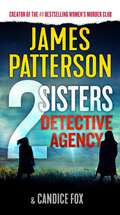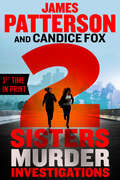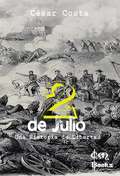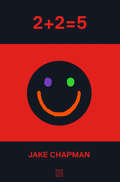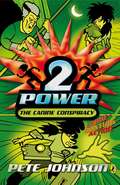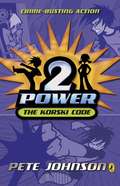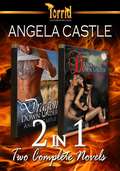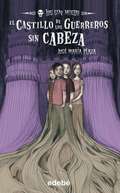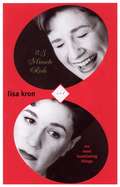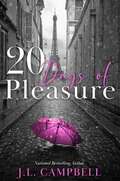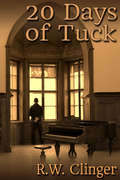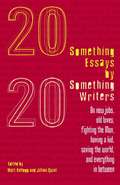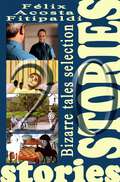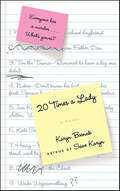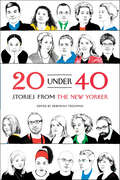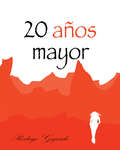- Table View
- List View
2 Nights With You: Two Nights Travel Club
by Olivia Gaines Tiana Laveen Jk RiversThree dynamic authors, three dynamite novels.College friends, Leah, Naima, & Yuri reunite for a fun filled weekend in Tahiti. The ladies check into an exclusive luxury resort as three beautifully crafted stories begin by taking the reader on a two-night, romantic adventure.Artfully woven romances bloom in a tropical paradise backdropped against a picturesque setting kicking off a personal transformation of all three women, with new men, new challenges, and loads of love.Come enjoy their weekend by reading Two Nights with You.
2 Pianos 4 Hands
by Ted Dykstra Richard GreenblattAmidst pushy parents, eccentric teachers, hours of repetitive practice, stage fright, the agony of competitions and exams, and the dream of greatness, Ted and Richard grow up as "piano nerds." As they mature, they become more aware of the gap between the merely very good and the great, and come to the humbling realization that concert stardom may be out of reach, but they just might be two of the best piano players in the neighbourhood, and that in itself is worth celebrating.
2 Sides of a Penny: Part One
by Carlton BrownLosing both parents to the cold Bay Area streets and a brother to the system, Jason can't help but shake the fear of being taken next. In his struggle to stay alive, and keep his brother Savion from being America's nightmare, he must also worry about Gooney's underhanded plans. Along with the love of his life Sheila, Jason moves heavy weight with the dreams of one day settling down and raising a family. A few blocks over, Italy is abused daily by her crack-addicted mother and longs for the love of her deadbeat father. Finally crossing paths, Jason proves to be a blessing and a curse to Italy, giving her a dose of reality on more than one occasion. As Italy's life spirals out of control, she's reminded of Jason's teachings but the boosting and drug dealing lifestyle has her trapped. What will it take for Italy to give up the street life? Will Jason reach his goal and retire from the game? 2 Sides of a Penny is a roller coaster ride through triumph and loss, love and hate, power and revenge, deceit and mutiny to see who will be the last breathing survivor.
2 Sisters
by Matt KindtSISTERS AGAINST THE WORLD!&“Kindt&’s work is more complex, ambitious and somber than its subtitle suggests.&”— Publishers WeeklyFrom the imagination of Matt Kindt, 2 Sisters is at once a fanciful World War II thriller full of codes, gadgets, and cyanide capsules and the heartbreaking story of Elle and Anna, whose shared past and secrets are dredged up when Elle is recruited into His Majesty&’s service as a covert agent!*From the creator of MIND MGMT, 3 Story, and Past Aways!*Over 300 pages of spy action—in color for the first time!
2 Sisters Detective Agency
by James Patterson Candice FoxFrom the world's #1 bestselling author comes a thrilling new standalone novel where a detective duo of sisters finds themselves in the crosshairs of a dangerous and lawless group. <p><p> Attorney Rhonda Bird returns home after a long estrangement when she learns her father has died. There she makes two important discoveries: her father stopped being an accountant and had opened up a private detective agency, and she has a teenage half sister named Baby. Baby brings in a client to the detective agency, a young man who claims he was abducted. During the course of the investigation, Rhonda and Baby become entangled in a dangerous case involving a group of overprivileged young adults who break laws for fun, their psychopath ringleader, and an ex-assassin victim who decides to hunt them down for revenge.
2 Sisters Murder Investigations: A Thriller (A 2 Sisters Detective Agency Mystery #2)
by James Patterson Candice FoxPatterson&’s greatest crime-solving team since the Women&’s Murder Club is the Bird Sisters. Rhonda and Barbara &“Baby&” Bird are half-sisters—and full partners in their Los Angeles detective agency. They agree on nothing. Rhonda, a former attorney, takes a by-the-book approach to solving crimes, while teenage Baby relies on her street smarts. But when they take a controversial case of a loner whose popular wife has gone missing, they&’re accused of being PIs who can&’t tell a client from a killer. The Bird sisters share a late father, but not much else…except their willingness to fight. Fight the system. Fight for the underdog. Fight for the truth. If they can stop fighting each other long enough to work together.
2 Sweet 2 B 4-Gotten (Friends 4-Ever, No #3)
by Deirdre CoreyA new friend for Laura? Nothing's going right for Laura. Her friend Molly has moved to Kansas for a year. And her other "Friends " Stevie and Meg, are in a different class and go to soccer practice after school. Laura doesn't play soccer. Worse still, since her mother's gone back to work, Laura has to go to the After-School Program every day with all the little kids. When Laura becomes friends with Shana, a new girl who feels the same way Laura does about the Afterschool Program. Laura tries to tell Meg and Stevie how nice Shana is, but all they do is make fun of Shana's spiky hair and wild earrings. So Laura asks advice from Molly. With Molly's help, can Laura convince her old friends to accept her new friend?
2 Timers: Love Sisters Series (Love Sisters #2)
by Amaleka MccallSista Love was a chart-topping girl group that had it all--fame, fortune and failure. After three years apart, Harmony, Melody, and Lyric are forced back together after the death of their mother. Their forced reunion rekindled past hurt, lies, and deceit, but it is new lies, backstabbing, and jealousy that will bring the sisters to the brink of destruction.Harmony is piecing her life back together after her husband's relapse back into addiction and his affair with her sister Melody. Now Harmony must decide if she will walk away or stand and fight. When she meets a handsome stranger, her decision will become that much harder. Will she become a two-timer, or will she give up on her marriage for good?Melody continues to throwing her money around to get what she wants. Still devastated by her ex-boyfriend's blatant two-timing, Melody turns to her sister's husband for comfort, but quickly realizes that he is only around because she is his constant supply of drugs and the fast life. With pressures mounting from all sides, Melody will have to figure out who she can trust. Will she risk it all to find love, or will her past come back to snatch her from her pedestal? Lyric is haunted by a secret she's kept from Harmony and finds out the hard way that turning back to drugs to run from her problems has landed her in the worst predicament of her life. Will Lyric let her addiction, once again, take her to the brink of death, or will she embrace sobriety once and for all?
2 de Julio - Una Historia de Libertad
by César CostaEsta es una obra de ficción basada en los hechos que ocurrieron durante los innumerables eventos del movimiento de liberación en Bahía. Los personajes ficticios que aquí aparecen, mezclados con otras tantas figuras reales e importantes del proceso de independencia, representan a los millares de héroes y heroínas anónimos que fueron tan importantes y decisivos para la victoria brasileña, como aquellos que tuvieron sus nombres destacados y perpetuados en la bella historia de valentía y voluntad del pueblo bahiano por una nación mejor, soberana y libre. Esta obra también es un homenaje a aquellos que renunciaron a su posición privilegiada en la sociedad colonial y a su relativa comodidad, para financiar y luchar por el bien común al lado de hombres considerados inferiores. Que cada lector comprenda que el proceso de liberación partió no sólo del grito soberano, sino de la sangre, sudor y lucha de muchos buenos ciudadanos brasileños repartidos no sólo en la provincia bahiana, sino por todo el territorio nacional; que los hombres que escribieron esta historia no fueron perfectos, mas prefirieron dejar de lado sus imperfecciones y deseos personales para que esta nación continental se fuera libre y hoy pudiera caminar bajo el lema: Orden y Progreso.
2+2=5 (Urbanomic / K-Pulp #4)
by Jake ChapmanA riotous new take on a classic fictional dystopia, with an all-you-can-eat quinoa buffet of wrongthink. With 2+2=5, George Orwell's flawed masterpiece finally receives a much-needed rectification, as Jake Chapman takes us on a bad trip into an atrocious alt-Eurasia--a nightmare utopia of 24/7 self-expression, mandatory wellbeing, yogic breathing, and promiscuous empathy. Yippie wonks in open-toed sandals have ejected the evil capitalist overlords, compassion and charity reign supreme, buckwheat salad and artisan cashew cheese are in plentiful supply, and all strive to live their best life, all the time.Employed by the Ministry to rectify misfortunes issuing from a curious glitch in the system, Winston Smith finds that his creative urges are unexpectedly awoken, and he is driven to express his deepest place, voice, and hurt through the medium of poetry. But what connects Winston's furtive scribblings in My Big Book of Me to the unpleasantnesses emanating from the deep glitch? Is Julia really the perfect kooky carefree soulmate she seems to be? Can O'Brien be trusted? And when does the new season of Big Brother start?An all-you-can-eat quinoa buffet of wrongthink, Chapman's twisted vision is a bracing reminder that dystopia is just wishful thinking, and that the worst can always get worster.
2-Power: The Canine Conspiracy
by Pete JohnsonTwins Sam and Ella have discovered they are extraordinary! They can send thought messages to each other and - when they're doing it - they have super powers!So, when pet dogs start to disappear, the twins decide to use their powers to solve the mystery -only to run headlong into danger . . .A thrilling read for children of 7+Comic-strip illustrations from Rowan Clifford are an exciting extra to every chapter.
2-Power: The Korski Code (2-power Ser.)
by Pete JohnsonSam and Ella are just an ordinary brother and sister - until they discover two amazing things . . .They can send thought messages to each other.They have incredible super powers.Suddenly they're extraordinary! And then a jewel robbery and a sinister stranger plunge them into a mystery that tests their new super powers to the limit!This is the first book in a brand-new series of thrilling crime-busting adventures aimed at younger readers of 7+. If you're a fan of Horrid Henry, then the 2-Power books are for you!
2-in-1: Angela Castle - Dragon Down Under & Dragon Down Under Two Plus One
by Angela CastleDRAGON DOWN UNDER: Accused of a crime he did not commit, dragon shifter Kaden, has been exiled to the human realm. His only chance for survival is to find a remote, warm dry place to live, as both man and dragon. Deeply in debt, Terrie Holbrook has no choice but to sell her family's remote cattle station in the far North of Australia, and a mysterious buyer saves the property from falling into the hands of a mining company. The overwhelming attraction between them has Terrie on the run, with one large, blue dragon on the chase. Things take a violent turn when the mining company owner comes after what lies beneath their land. They discover an ancient puzzle, dating back to the time of gods and men. When Terrie is threatened, Kaden must do whatever it takes to save his one true mate--and the world--from the hands of a mad man. DRAGON DOWN UNDER TWO PLUS ONE: Dar and Jax, two dragon shifters, exiled from the dragon realm, are forced to make a home--away from the humans--deep in the Australian desert. Their fortunes change when they find a curvy woman, near death, on their doorstep. The moment the brothers touch her, their inner dragons roar to life. She is a true mate, not just to one of them, but both. They must share her! Dar and Jax move quickly to heal their new treasure, claim her for their own and seek revenge on her ex-fiancée, who tried to kill their woman by leaving her to die in the desert.
2-in-1: Partners The Wrong Corpse & The Other Woman
by Kira ChaseTwo complete books in the erotic lesbian romance/suspense police thriller series, Partners, from author Kira Chase, including: PARTNERS: THE WRONG CORPSE: Twelve years ago Frankie Barker and Johanna Obrien became partners, then lovers, on the Philadelphia Police Force. After two years, the women were tired of city living. They quit the force and moved to Charlestown, Pennsylvania, where they built a log home and hung out their shingle as private investigators. In this first book of the series Partners, they take a case they feel will be a cinch to solve, before embarking on a much-needed vacation. But the case turns out to be much more than they bargained for! Graham McHenry hires Frankie and Johanna to follow his beautiful, much younger wife Cassandra, whom he believes is having an affair. They find the information their client is seeking, but the next morning they learn the woman has been murdered. The time of death places Cassandra at a motel, at the same time they had been following her to her mansion. Now McHenry wants to know who killed his wife, and Frankie and Johanna are determined to find out who they were tailing! PARTNERS: THE OTHER WOMAN: Private Investigators Johanna Obrien and Frankie Barker are planning a vacation with Johanna's visiting mother, Gracelyn, when a former lover of Johanna's shows up demanding that Johanna take her case. Gretchen Wyler is heavily involved in an investment scam which implicates Johanna and could destroy her life. The partners hatch a plan to trap Gretchen but Frankie's jealousy mounts when Gretchen puts the moves on Johanna. Meanwhile, Johanna must come to terms with the demons from her past and a secret she has kept from Frankie for all these years. A secret that could ruin their relationship forever. Look for book three in the series, PARTNERS: BLINDED BY THE TREES, available December 2011!
2. El castillo de los guerreros sin cabeza (LOS SIN MIEDO)
by Jose María Plaza¿Te atreves a pasar miedo de verdad? ¿No te asusta indagar en leyendas de castillos, conventos abandonados, casas que no existen o cementerios malditos...? Álvaro. Cris, Belén y David, la pandilla de Los Sin Miedo, te están esperando con sus terroríficas aventuras. Cerca del pueblo en el que veranean Los Sin Miedo se alza un misterioso castillo rodeado de un bosque envenenado. Según cuentan, nadie puede cruzarlo con vida. ¿Cuál es la causa? Y sobre todo, ¿por qué? ¿Qué ocultan sus viejos muros de piedra?
2.5 Minute Ride and 101 Most Humiliating Stories
by Lisa KronThis book collects Lisa Kron's two extraordinary solo performance works. Best known for her ongoing work as a member of The Five Lesbian Brothers, Kron's solo pieces are very personal examinations of both herself and her family history. This is singularly clear in 2.5 Minute Ride, where her writing deftly maneuvers between the tragic drama of the Holocaust and the wry comedy of her family's attempts to pursue pleasure at the local amusement park. This critically acclaimed work played to sold out audience for over six months at New York's Public Theatre. Also included is the riotous 101 Most Humiliating Stories, which first premiered in 1993, and in fact only consists of seventeen tales but each, as the author observes, has several humiliations. It recounts the adventures and misadventures of a self-described Big Lesbian as she tests the boundaries of decorum in social and professional situations.
20 Days of Pleasure (Days of Pleasure Series #2)
by J. L. CampbellNBA star Dallas Avery has one intention when he visits the most romantic city in the world—win Alicia Mitchell by any means necessary. They relish their time as a couple—free to explore their magnetic connection in Paris and savor the array of pleasures they discover as soul mates.But family, friends, the media, and society at large, have various opinions about their complicated relationship. Will Dallas and Alicia find a way to stay together, or will the many factors working against them shatter their once-in-a-lifetime romance?ABOUT THE DAYS OF PLEASURE SERIESEach Pleasures book is a standalone, NO cliffhangersUSA TODAY, and National Bestselling Authors take you on amazing journey with NBA Basketball Star, Dallas Avery, and Alicia Mitchell, a woman who is as mysterious as she is beautiful.Follow this unlikely couple as they travel to exotic places such as Paris, Durabia, Caribbean, Scotland and many others. Each story embroils them in a new set of challenges and adventure as they navigate their way to love.Book 1–10 Days of Pleasure by Stephanie M. FreemanBook 2–20 Days of Pleasure by J. L. CampbellBook 3–30 Days of Pleasure by Sierra KayBook 4–40 Days of Pleasure by Martha Kennerson and Stephanie M. FreemanBook 5–50 Days of Pleasure by Anita L. Roseboro and Michelle D. RayfordBook 6–60 Days of Pleasure by VanessaBook 7–70 Days of Pleasure by Christine PaulsBook 8–80 Days of Pleasure by Aiken PonderBook 9–90 Days of Pleasure by Marie L. McKenzie and Naleighna KaiBook 10—Open Door Marriage by Naleighna Kai
20 Days of Tuck
by R. W. ClingerFiction critic Micah Berk makes a point to spend as much time as possible with neighbor and pianist Tuck Martini. During twenty days of a particularly hot August on the shores of Lake Erie, the two men fall head over heels in love.A year later and life has unexpectedly changed for Micah. He meets and falls hard for Carl Bascoe, an irresistible and dark-haired carpenter. Carl is witty, romantic, and the sweetest guy along the lake.What happens when events from Micah’s past mix with those in his present? What will Micah do when various ties between his twenty days with Tuck and his current days with Carl begin to unravel? Will Micah finally experience the true meaning of endless love?
20 Something Essays By Twenty Something Writers
by Matt Kellogg Jillian QuintSelected as the winners of Random House’s national contest, a stunning collection of essays ranging from comic to poignant, personal to political, by the newest, brightest young writers you haven’t heard of . . . yet. Here, for the first time, current twentysomethings come together on their own terms, in their own words, and begin to define this remarkably diverse and self-aware generation. Tackling an array of subjects–career, family, sex, religion, technology, art–they form a vibrant, unified community while simultaneously proving that there is no typical twentysomething experience. In this collection, a young father works the late-night shift at Wendy’s, learning the finer points of status, teamwork, and french fries. An artist’s nude model explains why she’s happy to be viewed as an object. An international relief worker wrestles with his choices as he starts to resent the very people who need his help the most. A devout follower of Joan Didion explains what New York means to her. And a young army engineer spends his time in Kuwait futilely trying to grow a mustache like his dad’s. With grace, wit, humor, and urgency, these writers invite us into their lives and into their heads. Twentysomething Essays by Twentysomething Writers is a rich, provocative read as well as a bold statement from a generation just now coming into its own.
20 Stories: Twenty bizarre tales
by Félix Acosta FitipaldiHere you have twenty crazy, dark, ironic, and cruel stories. And, also, a humorous one. Each of them with a distinct theme and literary style. Let's have a look: She is waiting in the hall – Brief and simple. An appetizer in a cozy home before domestic chaos. Nenete – Emotive, strong, and sad. Unfortunately, a story that must have happened somewhere in real life. It won't be so easy – Death, depicted growing in her childhood, stalks a little boy who, dangerously, rides his tricycle near her. On wars as it is in duels –This blurb is not spoiler-free, so I suggest you read it after the story. (After a battle, the only survivor, dying, tells an anecdote to his comrades without knowing, in his delusion, that they are gone already.) Accelerated aging – This one was written when the author wasn't suffering from the symptoms that are narrated. He's confirmed his delusions. Time to scuttle away – It is Death again. This time, she's herding her flock under a storm. It'll make you think about the sense of existence. Flowers in the window – Macabre. An unfortunately frequent situation in which the victim manages to get free through murder. Conjugal sacrifices – A breather on the way. A man who, being under a lucky star, is given a gift he wasn't expecting. A little humor to dissipate the gloom from the previous stories. Tetrahedron – Many curious things can happen, if one tries to talk to oneself deeply. Especially, if oneself is a community. (The reader will find out why) A better life? - This lifetime's sorrows are extended beyond life and return thirsty for more. Ghosts in the attic – Along with "His match" and "The wind and the dogs" are the oldest triad of stories in this book. Kill the messenger – The passions and ambitions harbored by a group of men in a small town. A story about intrigue. Astrid – My favorite. The protagonist is a walking fail
20 Times a Lady: A Novel
by Karyn Bosnak“Bosnak writes with a charming and original voice.”—Chicago Sun-TimesA smart and bubbly romp, soon to be a major Hollywood motion picture starring Anna Faris, Chris Evans, Zachary Quinto, and Andy Samberg, What’s Your Number? by Karyn Bosnak asks—and answers—the provocative question, how many men are too many? When Delilah Darling exceeds her magic number of twenty ex-lovers without finding “Mr. Right,” she sets out on a hilarious road trip to discover what went wrong. Originally published as 20 Times a Lady, Bosnak’s What’s Your Number? has got the number of chick lit romantic comedy fans who are looking for a sassy read with true wit as well as brains.
20 Under 40: Stories from The New Yorker
by Deborah TreismanIn June 2010, the editors of The New Yorker announced to widespread media coverage their selection of "20 Under 40"—the young fiction writers who are, or will be, central to their generation. The magazine published twenty stories by this stellar group of writers over the course of the summer. They are now collected for the first time in one volume.The range of voices is extraordinary. There is the lyrical realism of Nell Freudenberger, Philipp Meyer, C. E. Morgan, and Salvatore Scibona; the satirical comedy of Joshua Ferris and Gary Shteyngart; and the genre-bending tales of Jonathan Safran Foer, Nicole Krauss, and Téa Obreht. David Bezmozgis and Dinaw Mengestu offer clear eyed portraits of immigration and identity; Sarah Shun-lien Bynum, ZZ Packer, and Wells Tower offer voice-driven, idiosyncratic narratives. Then there are the haunting sociopolitical stories of Chimamanda Ngozi Adichie, Daniel Alarcón, and Yiyun Li, and the metaphysical fantasies of Chris Adrian, Rivka Galchen, and Karen Russell.Each of these writers reminds us why we read. And each is aiming for greatness: fighting to get and to hold our attention in a culture that is flooded with words, sounds, and pictures; fighting to surprise, to entertain, to teach, and to move not only us but generations of readers to come. A landmark collection, 20 Under 40 stands as a testament to the vitality of fiction today.
20 años mayor
by Rodrigo GajardoVas a reír, sorprenderte y llorar. Pero lo más importante: te enamorarás. 20 años mayor es una novela que juega bruscamente con las leyes de las probabilidades. Te sorprenderás al saber lo que puede ocurrir con este mundo y lo que tal vez ya ha sucedido. ¿Puedes creer que viajar al futuro, es posible? La fantasía puede ser solamente una realidad oculta. La vida de Harry, un chico ordinario y ateo, cambia por completo cuando lo imposible parece ser posible. Cuando Jesús aparece en su vida, no solo duda de su existencia, sino que comienza una aventura que nunca esperó vivir. Su misión es clara: no puede enamorarse de Jesús.
20,000 Leagues Under The Sea
by Jules Verne Andrea M. ClareThe classic Verne tale, abridged and adapted by Andrea M. Clare and illustrated by David Grove.
